Due to its importance in foreign language learning in German schools the subject of English carries the main responsibility to develop the students’ competence for intercultural communication (cf. Göbel/Hesse). Accordingly, the KMK classifies intercultural learning as a key element of English language teaching and includes intercultural competence in the educational standards for grades 9 and 10 (cf. KMK 2003 & KMK 2004). Intercultural competence is described as contextual socio-cultural knowledge, the ability to deal with cultural difference sympathetically and the ability to master situations of intercultural contact (cf. KMK 2003: 8; cf. KMK 2004: 8). Including the cognitive and the affective level as well as the level of action alike, this description reflects the complexity of intercultural competence. The affective as well as the level of action are of particular importance if the teaching of culture is to be more than the teaching of facts as it was practised by the Landeskunde approach (cf. Nünning/Nünning). New approaches for an action- and product-oriented teaching of English are supported by empirical studies about intercultural sensitivity, which stress the relevance of emotions in situations of intercultural contact (cf. Göbel/Hesse). However, an analysis of the curricula of the German states shows that the main focus is on objectives of the cognitive dimension whereas learning aims of the affective level and the level of action are included less often (cf. ibid.). Moreover, many curricula lack information about which contents to use for teaching general aims like empathy, overcoming ethnocentrism and respect for cultural differences (cf. ibid.). Hence, the curricula are not sufficient for arranging a successful teaching of culture. The aim of this paper is therefore to obtain a more precise image of intercultural competence that illustrates the importance of all three dimensions involved. For this purpose, Byram’s comprehensive model of intercultural communicative competence will be presented in the first part as it reflects the complexity of intercultural competence through the interdependence of the different factors. On the basis of Byram’s model and the demands of the curriculum of North Rhine-Westphalia, the second part will develop suggestions for how to teach intercultural competence at school, considering all three dimensions of intercultural competence.
Inhaltsverzeichnis (Table of Contents)
- Introduction: Intercultural Competence - A Complex Teaching Aim
- Byram's Model of Intercultural Communicative Competence
- Intercultural Communication and the Intercultural Speaker
- Intercultural Competence
- Attitudes
- Knowledge
- Skills
- Critical Cultural Awareness
- Interdependence
- Communicative Competence
- Implications for Teaching Intercultural Communicative Competence
- Teaching Intercultural Competence by Use of Cartoons
- Curricular Issues
- Stereotypes
- Learning Aims
- Potential of Using Cartoons
- Cartoon Analysis - "Brain of Britain"
- Task Suggestions
- Conclusion: The Relevance of Intercultural Competence
Zielsetzung und Themenschwerpunkte (Objectives and Key Themes)
This paper aims to provide a detailed understanding of intercultural competence and its relevance in the context of foreign language teaching, particularly English, in German schools. The paper focuses on the three key dimensions of intercultural competence: cognitive, affective, and action-oriented. The main objective is to demonstrate the importance of including all three dimensions in the teaching of culture, going beyond the traditional Landeskunde approach. Key themes explored in this paper include:- Byram's model of intercultural communicative competence
- The role of attitudes, knowledge, and skills in developing intercultural competence
- The importance of critical cultural awareness and empathy in intercultural communication
- The potential of using cartoons as a teaching tool for intercultural competence
- The relevance of intercultural competence in contemporary society
Zusammenfassung der Kapitel (Chapter Summaries)
The introduction discusses the importance of intercultural competence in English language teaching in German schools and highlights the complexity of this concept. It introduces the paper's aim to provide a more precise understanding of intercultural competence, emphasizing the relevance of all three dimensions – cognitive, affective, and action-oriented. Chapter 1 presents Byram's comprehensive model of intercultural communicative competence, which provides a framework for understanding the multifaceted nature of intercultural competence. This chapter explores the key components of the model, including attitudes, knowledge, skills, critical cultural awareness, and interdependence. Chapter 2 focuses on teaching intercultural competence by utilizing cartoons as a pedagogical tool. It addresses curricular issues, stereotypes, learning aims, and the potential of using cartoons in the classroom. This chapter also presents a cartoon analysis of "Brain of Britain" and offers task suggestions for incorporating cartoons into teaching practice.Schlüsselwörter (Keywords)
This paper examines the key concepts of intercultural competence, communicative competence, cultural awareness, empathy, ethnocentrism, and the role of attitudes, knowledge, and skills in intercultural communication. It also explores the pedagogical application of cartoons as a tool for teaching intercultural competence and their potential in addressing curricular issues related to cultural diversity.- Arbeit zitieren
- Eleni Stefanidou (Autor:in), 2008, Teaching Intercultural Competence in Secondary Schools, München, GRIN Verlag, https://www.grin.com/document/115152



